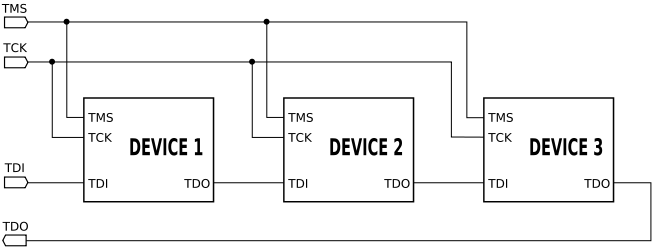RT1051 JTAG
- Mark as New
- Bookmark
- Subscribe
- Mute
- Subscribe to RSS Feed
- Permalink
- Report Inappropriate Content
We have a custom board project equipped with two i.MX RT1051.
We would like to use the JTAG connection, instead of the SWD, in order to link the two MCUs, as shown here
so we can only use one program/debug connector.
The preliminary step for us is to make the JTAG connection work on EVKB (taking care to pull up the JTAG_MOD signal). However, the connection is not established.
We have already read the post https://community.nxp.com/thread/483855 and https://mcuoneclipse.com/2017/12/16/mcuxpresso-ide-v10-1-0-with-i-mx-rt1052-crossover-processor/ (I added a comment there, too. https://tinyurl.com/y8dxchbu)
We wonder where we're wrong. And we wonder if the RT105x supports JTAG for programming and debugging or just boundary scan.
best regards
Max
- Mark as New
- Bookmark
- Subscribe
- Mute
- Subscribe to RSS Feed
- Permalink
- Report Inappropriate Content
Hi Max
to support JTAG it is necessary to program the eFUSE to enable JTAG
(please check fuse DAP_SJC_SWD_SEL in Table 5-9. Fusemap Descriptions
i.MXRT1050 Reference Manual) as default eFUSE cofiguration is for SWD.
Best regards
igor
-----------------------------------------------------------------------------------------------------------------------
Note: If this post answers your question, please click the Correct Answer button. Thank you!
-----------------------------------------------------------------------------------------------------------------------
- Mark as New
- Bookmark
- Subscribe
- Mute
- Subscribe to RSS Feed
- Permalink
- Report Inappropriate Content
so the thing I wanted to do can't be done?
If a blank RT1051 has enabled SWD by default and not JTAG, and is mounted on a board as follows
it will never be possible to program the QSPIs of both and debug both.
So I guess putting the microcontrollers in the daisy chain isn't possible, is it?
best regards
Max
- Mark as New
- Bookmark
- Subscribe
- Mute
- Subscribe to RSS Feed
- Permalink
- Report Inappropriate Content
I think you are right, first jtag should be enabled.
Best regards
igor
- Mark as New
- Bookmark
- Subscribe
- Mute
- Subscribe to RSS Feed
- Permalink
- Report Inappropriate Content
So the rt1050 has a claimed feature that, in fact, is not usable?
However, I think that #1 should have JTAG enabled, because on #2 I can use SWD to program the DAP_SJC_SWD_SEL fuse to it.
best regards
Max
- Mark as New
- Bookmark
- Subscribe
- Mute
- Subscribe to RSS Feed
- Permalink
- Report Inappropriate Content
rt1050 has jtag and it is usable. But you should use
it properly, strictly following documentation. May be useful to check:
arm - How to daisy chain SWD Debug port - Electrical Engineering Stack Exchange
Best regards
igor
- Mark as New
- Bookmark
- Subscribe
- Mute
- Subscribe to RSS Feed
- Permalink
- Report Inappropriate Content
I try to say it in other words.
the connection as shown here
is compliant with IEEE 1149.1, there should be no doubt about that.
If I make and assemble a board with two microcontrollers connected as in this figure, however, the board will be unusable, or am I wrong?
best regards
Max
- Mark as New
- Bookmark
- Subscribe
- Mute
- Subscribe to RSS Feed
- Permalink
- Report Inappropriate Content
according to link
arm - How to daisy chain SWD Debug port - Electrical Engineering Stack Exchange
"While JTAG supports a daisy chain configuration, SWD does not."
so you should enable jtag for using this circuit.
Best regards
igor
- Mark as New
- Bookmark
- Subscribe
- Mute
- Subscribe to RSS Feed
- Permalink
- Report Inappropriate Content
when should I enable JTAG on the micros? Should I program the fuse DAP_SJC_SWD_SEL before mounting it on the board? And how can I do that?
Suppose you are given a board with two blank microcontrollers connected as shown in the figure. Both microcontrollers are configured in SWD (default). So how do I configure their debug port as JTAG? How can I write their QSPI flashes? How can I debug them?
I know the limits of SWD with regard to the daisy chain. I was hoping there would be a way to daisy chain two blank micros.
best regards
Max


